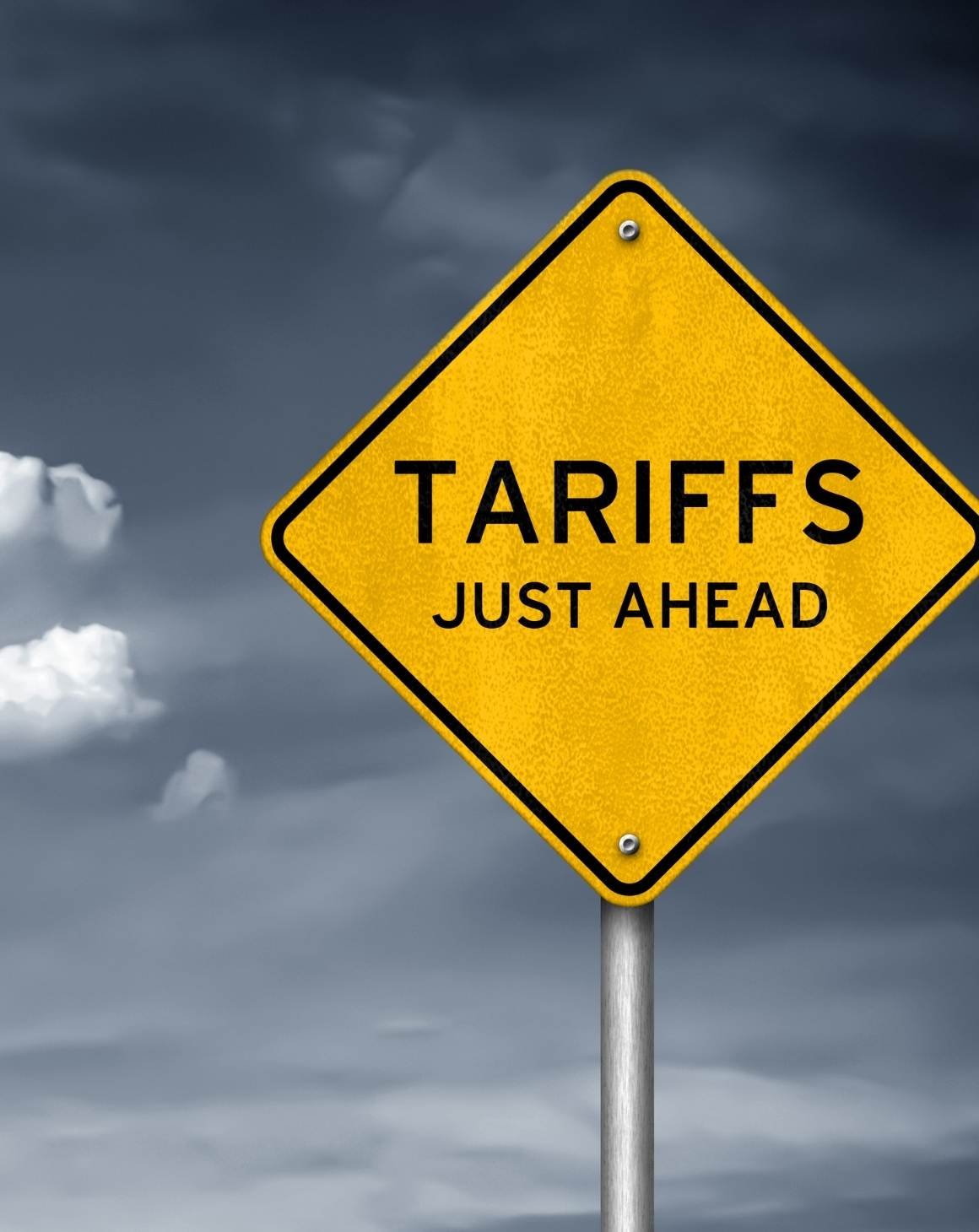As new U.S. tariffs roll out in 2025, eCommerce brands are preparing for a wave of potential disruption, from rising product costs to shifts in consumer spending and evolving marketing strategies. While the economy remains relatively resilient, these trade changes are expected to ripple across supply chains, media budgets, and brand communications.
At Blue Wheel, we work with eCommerce brands every day, through market shifts, supply chain disruptions, and economic pressures. And what we’ve learned is this: brands that stay agile, thoughtful, and connected to their customers often emerge stronger.
In this article, we break down the economic backdrop, key consumer behavior shifts, and what brands should do now to stay ahead.
The Economic Picture: Growth With New Pressure
The U.S. economy grew at a 2.4% annual rate in Q4 2024, largely fueled by strong consumer spending. Household incomes rose 4.6%, helping boost retail and eCommerce performance but signs of softening are emerging. The personal savings rate dropped to 3.7%(down from 4.1%), suggesting consumers are dipping into savings to maintain spending levels.
As tariffs raise the cost of goods, this tension between consumer optimism and financial caution could shape demand in 2025.
Consumer Behavior is Already Shifting
Tariffs and inflation concerns are changing how people shop. According to recent reports:
- 82% of Americans are concerned about rising costs for essentials like food, gas, and housing.
- 51% of consumers have changed their buying habits — with Gen Z (67%) and Millennials (61%) leading the shift.
- 46% of shoppers plan to buy secondhand goods to save.
- Products labeled “Made in the USA” are seeing growing traction as shoppers prioritize domestic alternatives.
We’re seeing amore value-conscious consumer emerge; one who wants to stretch every dollar, make more intentional purchases, and support brands that feel aligned with their values. This isn’t just a pricing issue, but a relationship-building opportunity.
These changes signal a more value-conscious consumer mindset and brands will need to adjust their positioning accordingly.
Implications for eCommerce & Marketing Strategy
As product costs increase, many brands are revisiting their media mix, creative strategy, and customer messaging.
These shifts are forcing brands to take a closer look at everything. As product costs increase, many brands are revisiting their media mix, creative strategy, how products are sourced, and how customers are communicated with.
Here are some of the key moves we’re seeing brands make:
- Rebalancing Media Budgets: Some brands are tightening ad budgets to offset rising COGS, while others are shifting more dollars to performance-based channels to justify ROI. Cutting costs doesn’t have to mean cutting corners. Many brands are shifting spend toward performance-driven channels while still protecting long-term brand equity.
- Rethinking Influencer & Sponsorship Strategies: Brands in categories hit hardest by tariffs (e.g., fashion, home) are strategically thinking their influencer campaigns or becoming more selective. Fast fashion leaders like Shein and Halara have already pulled back in this area.
- Doubling Down on Transparency: Price hikes can erode trust unless handled proactively. Brands that clearly communicate the “why” behind pricing, including sourcing changes or tariff impacts will be better positioned to retain loyalty.
- Supply Chain Diversification: To mitigate risk, some brands are exploring domestic or tariff-free suppliers, which may become a key marketing angle in 2025.
Navigating Tariff Concerns for eCommerce
As tariffs and inflation reshape the economic landscape, eCommerce brands are facing complex decisions: where to cut, where to double down, and how to protect long-term growth. The key is to stay nimble, data-driven, and customer-focused.
Here’s a play book for brands to navigate the months ahead:
1. Invest Wisely. Frugality Doesn’t Mean Going Cheap
In uncertain times, effectiveness matters more than volume. Avoid across-the-board cuts and instead prioritize high-intent audiences and measurable channels. Every dollar should be tied to performance, but that doesn’t mean starving brand investment.
Keep your retention engine running. Invest in loyalty, reactivation, and customer experience to hold onto the customers who are still spending.
Tip: Focus on retail media, performance marketing, and campaigns with strong conversion potential. Don’t pull back so far on brand-building that you lose long-term traction.
2. Audit Your Exposure & Reevaluate Sourcing
Understand where tariffs hit hardest in your product mix and supply chain. Evaluate which SKUs, suppliers, or fulfillment partners are most exposed and build a proactive plan to adjust pricing, margin expectations, or inventory strategy.
If you’re exploring nearshoring, reshoring, or diversified sourcing, communicate that clearly. “Made in the USA” and responsible sourcing aren’t just cost mitigation they’re also powerful brand stories.
Tip: Turn your supply chain shift into a trust-building message your customers can rally around.
3. Consider the Long-Term Impacts of “Going Dark”
Not all online retailers operate the same and marketplaces like Amazon and Walmart.com require consistent investment to maintain visibility.
Pulling back on ads and cutting promotions “cold turkey” will almost certainly cause rankings to plummet, making it harder and more expensive to recover. These platforms are algorithm-driven: stop fueling them, and you lose momentum fast. Divesting too aggressively can put a brand in a hole that takes months (and significant budget) to dig back out of.
Tip: Instead of pulling spend entirely, restructure campaigns around profitable SKUs, optimized ROAS targets, and adjusted promotion calendars, but stay active.
4. Reclaim Share from Private Label
Tariff-driven price increases will affect all brands, including low-cost private labels and offshore competitors. If you’ve lost share in recent years to cheaper alternatives on Amazon, now is your chance to win it back.
As price gaps narrow, shoppers are more likely to reconsider established, trusted brands, especially if you pair competitive pricing with elevated content, improved reviews, and a refined brand story.
Reinvest in PDP optimization, premium A+ content, and branded storefronts. Run retargeting campaigns focused on high-consideration audiences who previously bought competitors. Use Subscribe & Save or loyalty messaging to lock in repeat buyers.
Tip: This is a moment to get aggressive — not passive — in marketplaces. When shoppers are recalibrating what value means, brands that show up well-positioned can earn back market share that was lost to short-term price plays.
5. Make Your Value Proposition Unmissable
With consumers scrutinizing every purchase, brands must clearly communicate why they’re worth it. Price increases are inevitable, but if they’re paired with messaging that reinforces durability, utility, efficiency, or ethical production, shoppers are more likely to stay loyal.
6. Let Data and Intelligence Drive Every Move
Guesswork is expensive. Now is the time to lean into analytics. Let real-time performance insights guide your media mix, pricing strategy, and messaging. Track demand signals closely, evaluate what’s actually working, stay agile, and adjust fast.
The most resilient brands during past recessions were those that adjusted quickly and with precision.
7. Don’t Just Survive, But Accelerate
Periods of economic pressure often accelerate change. Just like the 2008 crisis hastened the rise of digital, today’s environment is fast-tracking Retail Media, CTV, and AI-powered marketing. Brands that lean into innovation, not just cost-cutting, will gain long-term advantage.
Tip: Don't just play defense. Use this moment to restructure for what’s next.
8. Plan for Agility Across the Board
Build flexibility into your media budgets, sourcing plans, and campaign timelines. This isn’t the time for rigid annual plans.
Tip: Set checkpoints every 30–60 days, monitor economic shifts, and be ready to pivot fast.
Our Message to You: You’re Not Alone
If you’re staring at rising costs, shifting margins, or hard decisions, know this: your brand isn’t alone in navigating this landscape.
We’re working with our brands across categories to help them adapt, from refining their marketplace strategy to rethinking how they invest their media dollars.
Whether you’re managing changes internally or working alongside a trusted partner, Blue Wheel is here to support you through the uncertainty with strategies grounded in data, profitability, and long-term growth.
Here’s how we’re helping brands adapt and stay ahead:
- Amazon margin tracking by SKU so you know exactly where you can protect profitability.
- Ad campaign strategies built around margin goals, not just spend efficiency—across Amazon, Walmart, DTC, and more.
- Cross-channel expansion planning to move from DTC to marketplaces (or vice versa) with confidence.
- DSP and AMC expertise to help you unlock deeper insights and target both new and returning customers with precision.
- Influencer and social strategies tailored to stretch organic reach while aligning with your brand values.
- Email and SMS marketing that drives high-intent traffic and supports sales without relying on paid media alone.
If you’re feeling the pressure and need help protecting margins, rebalancing ad spend or simply want to future-proof your strategy, we’re here to help. Our team is ready to meet you where you are and move forward, together.
Final Takeaway
Tariffs and economic headwinds create pressure but also opportunity. Brands that move with clarity, not fear, and balance short-term adjustments with long-term strategy are the ones that will gain ground.
If you're unsure where to start, from rethinking your marketplace strategy to resetting your media mix, we’re here to help.








.png)
.png)
